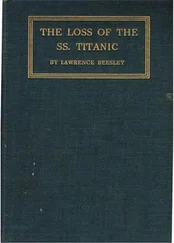Many, like Mrs Malaha Douglas, who was returning home from a furniture-buying trip in Europe with her husband — the heir to Quaker Oats — remembered Ismay getting into the first boat to leave. One of the ship’s firemen, Harry Senior, agreed. ‘I saw the first boat lowered. Thirteen people were on board, eleven men and two women. Three were millionaires and one was Ismay.’ Mrs Charlotte Drake Martinez Cardeza, travelling with fourteen trunks of new clothes from Paris, said that Ismay was the first person to climb into the first boat to leave and that he selected his own crew to row him away. Mrs Cardeza’s son Thomas, on the other hand, who was in the same boat as his mother, told a reporter that the women in their boat, one of the last to leave, had begged Ismay to join them. ‘“Mr Ismay, won’t you come with us? We will feel safer.” “No,” Ismay said, “I will remain here and not take the place of any women.”’ It was only under pressure, Thomas Cardeza recalled, that Ismay was eventually persuaded to climb in. Edward Brown, a first-class steward, remembered Ismay standing, not on the deck to help the women and children into Collapsible C, but inside the boat itself, ready to receive them. But according to Georgette Magill, aged sixteen, Ismay got into the ‘last boat’ of all, and only then because he had been ordered to do so by Captain Smith himself.
One reason for the conflicting accounts of Ismay’s actions was the chaos of the night. It was, a passenger recalled, ‘too kaleidoscopic for me to retain any detailed picture of individual behaviour’. 2Added to which, very few people, apart from some members of the crew and a small circle of first-class passengers, knew who Ismay was or what he looked like. It was simply not possible to see where amongst the crowds various individuals were standing and into which of the boats they were climbing. Port and starboard were two separate neighbourhoods. The Titanic was a sixth of a mile long and the decks were like avenues; the corridors inside were even named after streets such as ‘Park Lane’ and ‘Scotland Road’. It took Second Officer Charles Lightoller, who had spent twenty years at sea, several days before he could find his way from one end of the ship to the other by the shortest route.
Those who did know Ismay had different versions of his departure from the Titanic, all of which served their own interests. August Weikman, the ship’s barber, swore in an affidavit that Ismay was ‘literally thrown’ into Collapsible C by an officer: ‘Mr Ismay refused to go, when the seaman seized him, rushed him to the rail and hurled him over.’ Weikman, who was rescued from a floating deckchair, had been given a first-class barber’s shop on every new White Star liner and, as Ismay’s personal barber, considered himself a friend. Lightoller, another loyal White Star Line employee, agreed that Ismay had been ‘thrown’ into a boat by Chief Officer Wilde.
But Ismay always denied the suggestion that he was obeying orders when he jumped into Collapsible C — a fact that would have entirely exonerated him from the accusation of cowardice.
Quartermaster George Rowe, the seaman put in charge of Collapsible C, said under oath that no one invited or ordered Ismay to jump in, and that Ismay had jumped in before, and not after, the boat had started to be lowered. ‘The Chief Officer wanted to know if there were any more women and children,’ Rowe told the US inquiry. ‘There were none in the vicinity. Two gentleman passengers got in; the boat was then lowered.’ But forty years later, in a letter to Walter Lord who was compiling eyewitness accounts for his book, A Night to Remember, Rowe recalled it differently. In his revised account, he only noticed Ismay’s presence when the boat had nearly reached the water level, and he had no idea how or when the owner had left the Titanic. ‘We had great difficulty in lowering as the ship was well down by the head… it was then that I saw Mr Ismay and another gentleman (I think it was a Mr Carter) in the boat.’ 3
William E. Carter, who had jumped into Collapsible C at the same time as Ismay, was an American polo-playing millionaire who belonged to the Philadelphia fast set. The Carters were currently based in England, where their son was at school, and were returning to their country house with a new $5,000 Renault motor car in the hold of the ship. In an interview for The Times on 22 April, Carter said that after ‘waving’ off his wife, Lucille, and their two children who were seated in a lifeboat launched on the port side, he crossed over to starboard where he and Ismay were invited into Collapsible C by an officer: ‘As the last boat was being filled we looked around for more women. The women in the boats were mostly steerage passengers. Mr Ismay and myself and several officers walked up and down the deck, crying, “Are there any more women here?” We called for several minutes and got no answer. One of the officers then said that if we wanted to, we could get into the boat if we took the place of seamen. He gave us preference because we were among the first-class passengers. Mr Ismay called again, and after we had no reply we got into the lifeboat. We took oars and rowed.’ When their lifeboat was launched, Carter said, ‘the deck was deserted’. William Carter corroborates Ismay at every turn: ‘our narratives are identical; the circumstances under which we were rescued from the Titanic were similar. We left the boat together and were picked up together.’ 4‘I hope I need not say,’ declared Ismay, ‘that neither Mr Carter nor myself would, for one moment, have thought of getting into the boat if there had been any women there to go in it.’ But Lucille Carter seems to have been still on the ship when her husband jumped into Collapsible C; it was not until fifteen minutes later that she and her children were given places in boat number 4. In 1914 Mrs Carter filed for divorce, claiming among other things that her husband William E. Carter had deserted her on the Titanic.
The women passengers in Collapsible C remember the loading of their boat differently. Margaret Devaney, an Irish third-class ticket holder aged nineteen, recalled being ‘caught in a crowd and pushed into Collapsible C’, and Waika Nakid, a Lebanese passenger also aged nineteen, whose twenty-year-old husband, Sahid, managed to get in with her, saw two men from Lebanon being shot at: terrified for her husband, she and some other women covered Sahid with their clothes. On the twenty-fifth anniversary of the Titanic, another Lebanese passenger, Shawneene George, confirmed Waika Nakid’s story in an interview with the Sharon Herald: ‘Sailors armed with revolvers drove the men away from the boats shouting, “women and children first!”. They shot into the air to frighten the men. Many passengers were overcome with fright… A scared young man leaped over the side of the liner and landed in the bottom of the lifeboat. Women shielded him with their night clothing so that sailors would not see him. They would have shot him.’ Reports of gunfire also came from one of the ship’s firemen, Walter Hurst, and Hugh Woolner, an English first-class passenger who eventually jumped into Collapsible D (the last boat to be launched) said that ‘two flashes of a pistol’ alerted him to a group of ‘five or six’ men climbing into Collapsible C. ‘We helped the officer to pull these men out, by their legs and anything we could get hold of.’ Woolner then helped to load the boat with women. One of these, Emily Badman, an eighteen-year-old servant from Southampton, told the Jersey Journal how she pushed through crowds to get to Collapsible C; May Howard, a twenty-seven-year-old laundry worker emigrating to Canada, told the Orleans American that: ‘One of the officers grabbed Mrs Goldsmith and myself and pushed us to the edge of the ship where the lifeboat [Collapsible C] was being filled with women and children first’; Mrs Emily Goldsmith, emigrating to America with her family, said that Collapsible C was surrounded by a line of seamen with linked arms, who were allowing only women and children through. Amy Stanley, a twenty-year-old servant from Oxfordshire, said that ‘as we were being lowered a man about 16 Stone jumped [in] almost on top of me. I heard a pistol fired — I believe it was done to frighten the men from rushing the boat.’
Читать дальше












